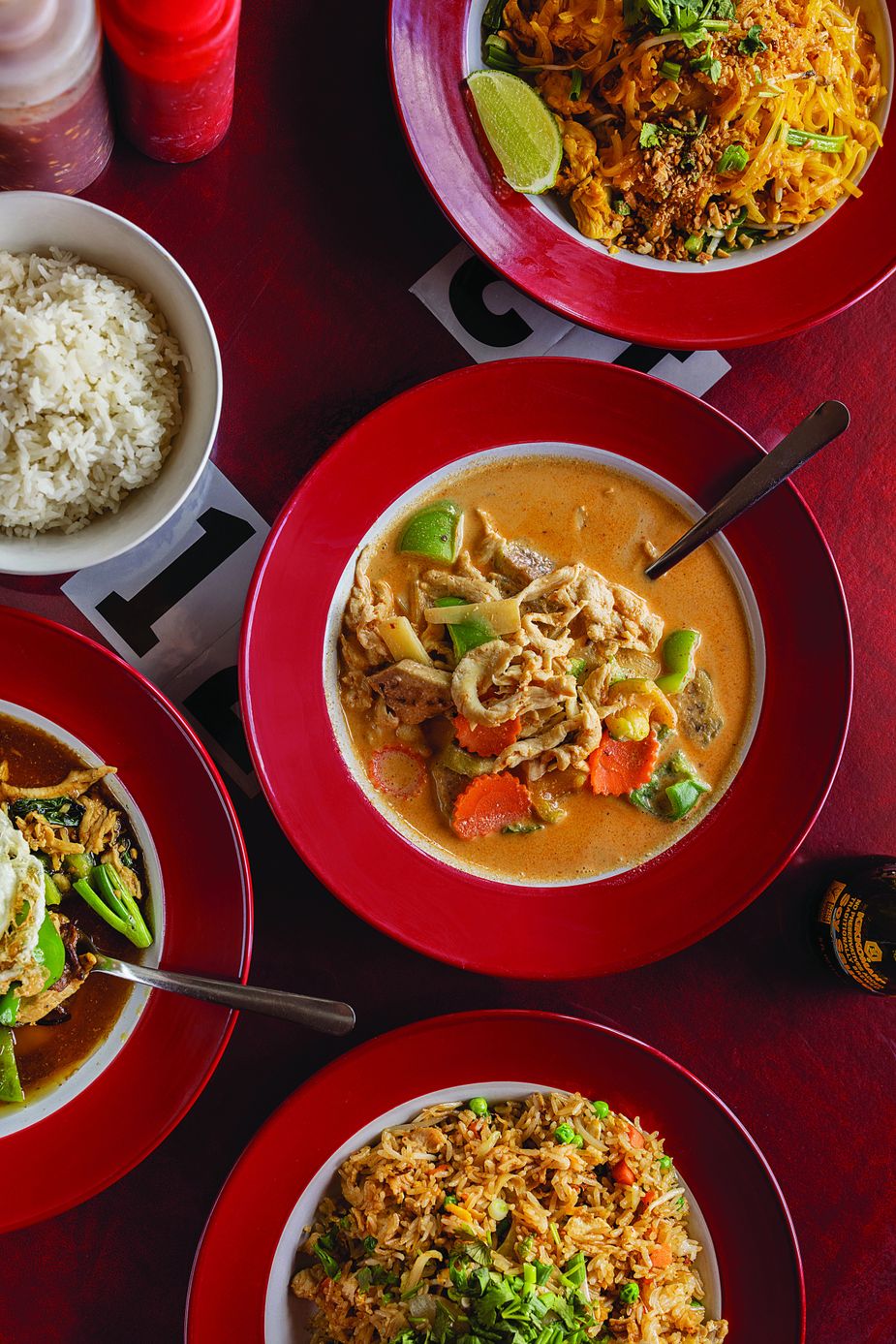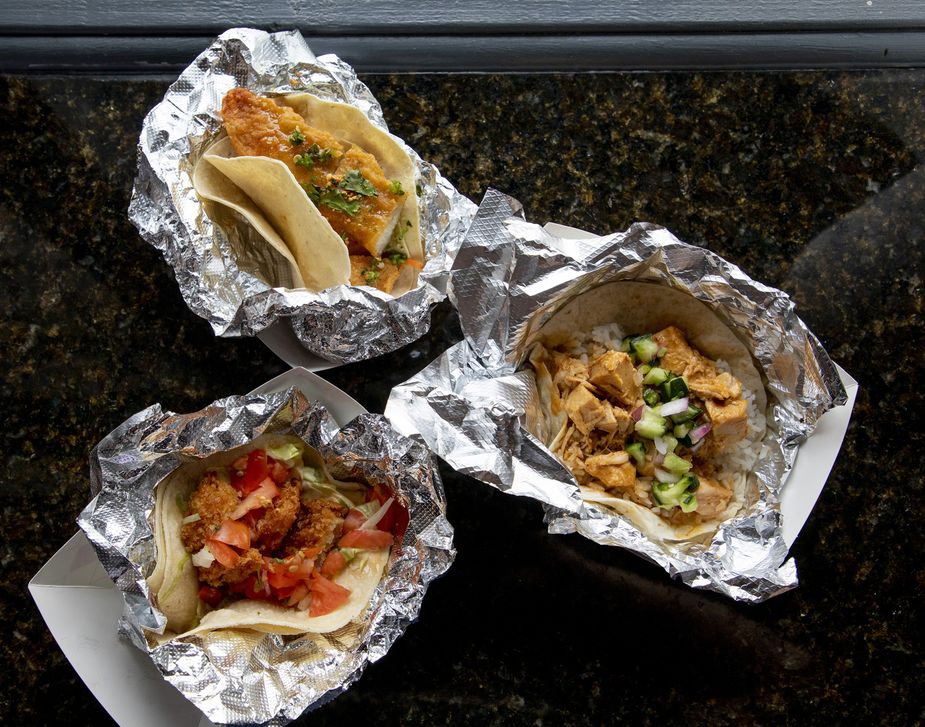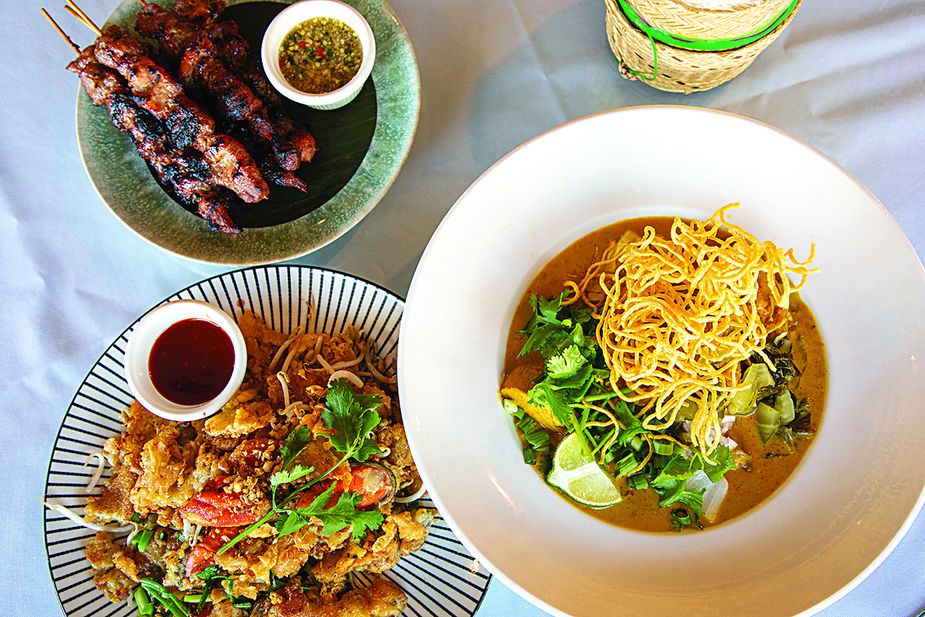Thai Minded
Published March 2023
By Becky Carman | 15 min read
In Thailand, the cuisine gets spicier the farther south you go. This also is true in Tulsa.
Thai Village, sharing a corner with Oral Roberts University and open since 2009, is one step ahead of most area Thai restaurants on the Scoville scale.

Curries, pad thai, and fried rice all are familiar Thai staple dishes served at Thai Village in Tulsa. Photo by Valerie Wei Haas
“Our mild is gonna taste like medium. If they want medium, it’s gonna taste like hot,” says owner Paul Her. “We also offer Thai hot, extreme hot, and ‘as hot as it gets,’ which will kill you if you’re not a spice eater.”
The “as hot as it gets” crowd, as you might imagine, is more thrill-seeker than culinarian. Many have tried, some have quit, others have cried or thrown up, and a few have managed to eat an entire plate of palate-obliterating noodles, which Her says are ten times hotter than Thai hot. These brave souls win a T-shirt or a hat and a shout-out on the restaurant’s Facebook page—but they still pay for the meal. (Her, for the record, likes his food Thai hot.)
Thai food is a master class in balancing spicy, sweet, salty, and sour—panic-inducing quantities of chilis are not how Thai people eat daily. Instead, the occasionally overweening heat is a modern mutation of one of the cuisine’s defining features. For those looking for an authentic Thai experience, though, it ticks all the boxes. What could be more genuine than a chef using the ingredients available to him to entice new diners to try his food?
That’s the rub on non-native cuisines and the hunt for authenticity: Singular dining experiences outside of Thailand are just that—one-off glimpses of the unfamiliar. If you have had one cheeseburger, you have not had them all, and the same is true of pad kee mao. What’s available to Oklahomans are slivers on the spectrum, ingredient substitutions, and personal and familial recipes passed down or invented by newcomers to the U.S.
Her is ethnically Hmong, born in a refugee camp in Thailand after his parents fled there at the end of the Vietnam and Laotian Civil Wars. Six years later, the family came to Minnesota, eventually moving to Michigan, where they had family. After studying business administration and working in retail management, Her relocated to Oklahoma to jump into the restaurant business along with a cousin and a couple of friends. He was following his uncle, who had purchased the now-closed Thai-Siam, and experienced the state’s taste for Thai cuisine firsthand.
Thai Village’s food is what Her calls Michigan Thai—the reimagining of Thai food by immigrants and refugees using what ingredients were available upon their arrival to the U.S. This was before fish sauce was a household term and the number of Thai restaurants outpaced the Thai population versus other ethnicities. Her’s recipes have become an Oklahoma-Michigan-Thai hybrid of sorts.

Thai Loco's fusion menu includes tacos filled with crispy chicken, Thai fish, and Thai chicken curry. Photo by Lori Duckworth
“With the internet and the melting pot, more people are open to other cultures,” Her says. “Even authentic food is going to be more fusion in the future.”
Michigan Thai means granulated sugar versus palm sugar, for one thing, and maybe peanut butter instead of peanuts or dairy instead of coconut to make curries creamier. One Michigan Thai import to Tulsa that may surprise some diners is Her’s cheese pad thai, an unabashedly heavy fusion dish that warmed people up during Michigan winters and is perfectly suited for Oklahoma’s Southern palates.
“It’s very tasty, but you cannot eat the whole thing in one sitting. If you do, you’re gonna go to sleep,” Her says.
Peanut butter and American cheese may not feel like Thai cuisine, but at least here, they are. At Thai Loco in Stillwater, a native Thai chef creates burritos and tacos with Thai flavors. Or you can try drunken spaghetti—a riff on pad kee mao, or drunken noodles—at Pan’s Thai Express in Owasso, a popular food truck. These are fusion products born from individual culinary identities. They’re also a welcome mat for anyone hoping to explore Thai food without knowing where to start. Most people, though, start with pad thai.
“Everybody has heard of pad thai,” Her says. “Even if they have never had Thai food, even tasted pad thai, if you say ‘pad thai,’ they go, ‘Oh, okay.’”
This is not a coincidence. In addition to pre-World War II efforts by Thailand’s leaders to make pad thai a boon to Thai nationalism, the refugee exodus from Thailand and surrounding countries in the late 1970s and early ’80s brought huge numbers of immigrants to the U.S. In 2017, the Association of Southeast Asian Nations estimated the number of Thai, Laotian, and Hmong immigrants in the state between seven and eight thousand. The Thai government runs an ongoing gastrodiplomacy campaign that started in the early 2000s to position Thai cuisine as an economic and cultural export. Many of Oklahoma’s beloved Thai institutions got a leg up on the idea, however, by bringing Thai dishes, including pad thai, to the state well before then.
“Pad thai is number one,” says Benji Sukmanee, who co-runs Oklahoma City’s Thai House with her mother Pranee. The family opened the restaurant in 1993, having followed Pranee’s sister to Oklahoma after she was sponsored to come to the U.S. in 1979.
The restaurant shuttered its buffet during the COVID-19 pandemic—for any hopefuls, the staff confirmed there are no plans for it to return—and is transitioning to a new menu. The family’s favorites from the old recipes will make the cut, including hoy tod, a crispy crepe with mussels and crunchy bean sprouts, and the northern Thai specialty khao soi, a creamy chicken curry broth with crispy and soft egg noodles. Thankfully, it’s not all pad thai and fried rice for Benji.
“We do have a few adventurous souls who eat here regularly and have been ordering nam khao tod, and our sausage has been selling a lot,” she says.
Nam khao tod is a crispy rice salad native to Laos, where Pranee is originally from, though it’s a fixture in Thai restaurants. The dish is fried rice balls served with a tart, herbaceous dressing of fish sauce, lime juice, and ginger, and it’s a far cry from the noodle dishes Thai food beginners are familiar with. The menu has a couple of Lao offerings as well as dishes offered in both Lao and Thai variations, including sausage, where the Lao version features red curry paste and lime leaves and the Thai version is flavored with rice and herbs. The som tom, or papaya salad, also is served either way.

Po tak is a spicy, traditional Thai soup made with shrimp, fish, and mussels that’s served at My Thai Kitchen in Tulsa by owner Noot Jintaseranee. Photo by Valerie Wei Haas
“The Thai palate is sweet, sour, spicy, and Lao is very earthy,” says Thailand-born Benji. “If I eat Thai noodles, I want sugar, vinegar, and jalapeños, so the Thai papaya salad is sweet, sour, and spicy, and the Lao one has fermented, unfiltered fish sauce. It’s the agent for the umami, and we make it in-house. That’s the stinky sauce, but it’s good.”
After a quick back-and-forth with her daughter in Thai, Pranee says that previous batches of her unfiltered fish sauce, or padaek, have fermented for five, seven, even ten years. She also says, with a smile, that Benji doesn’t really eat it.
This intergenerational fish sauce divide is a great example of how Thai cuisine is no monolith—there are overlaps with Laotian, Vietnamese, and Chinese cuisines, with preferences in one end of the country distinguishable from the other, or even from mother to daughter. Where Pranee’s food is Lao and classic Thai, Benji creates dishes that are Thai, Lao, Oklahoman, and Oklahoma City Asian District. Her specials recently have included Japanese noodles with Thai flavors like braised short rib drunken ramen and beef panang udon.
Where Benji’s culinary perspective is bolstered by an interest in fusion and a knack for food photography and social media, Pranee has zero interest in taking photos of her food or playing with what Thai food really means. Both positions are valid, if a little incongruous in a single restaurant kitchen.
Up the turnpike, a second-generation Thai restaurant owner runs the show, though she’s only in the business because she wanted to sate Tulsa’s appetite for a very specific region of Thai cuisine: her mother’s kitchen. Noot Jintaseranee grew up working in her parents’ restaurant, Thai-Siam, starting when it opened in 1990 and ending when they sold it in 2007. Thai-Siam was a giant in Tulsa, and in the years following its closure, Jintaseranee was approached often by lifelong customers of her parents, asking when they’d be able to eat this food again.
In 2010, she acquiesced, opening My Thai Kitchen with the family’s recipes. The restaurant carries over the gentle diplomacy of an early ’90s “ethnic” restaurant with familiar Chinese-American staples: Soy sauce is on the table, and fortune cookies come with the check.

Moo ping skewers, hoy tod (crispy green mussels fried in egg), and khao soi (chicken curry broth with noodles) are among the most popular dishes at Oklahoma City's Thai House. Photo by Lori Duckworth
Pad thai and drunken noodles run head-to-head for most popular dish at My Thai Kitchen. Jintaseranee’s drunken noodles have a burnished, almost barbecue flavor owing to high heat and a proprietary mix of soy sauces. The dish also includes broccoli, which she identifies as a westernized substitution.
“I had never seen broccoli when I was a kid in Thailand, for real,” she says. “Not the kind with the flower head.”
Jintaseranee attended an intensive, three-month cooking school across Thailand, and My Thai Kitchen’s menu spans regional cuisines. The popular noodle dishes of central Thailand are the most well-known, but she also makes rad na, a Chinese-influenced Thai dish of rich brown gravy served with noodles or crispy fried wontons. On her wish list for people to try is po tak, a fisherman's stew made with shrimp paste and a tart, refreshing flavor that belies its fiery color.
The house-made chili sauces and sweet and sour sauce are free to all diners, but if you read the menu closely, you’ll find an upcharge option that underscores the restaurant family’s relationship to its customers: You can order your chicken Dan’s Style—stir-fried separately in the sauce and served atop your dish—so-named for a longtime patron of both restaurants.
It speaks to the appetite for and ubiquity of Thai food in that Oklahoma diners are not only supporting Thai restaurants—there are several dozen in the Oklahoma City area alone—but they’re developing specificity and regional favorites. These businesses may all be connected by threads of coconut and fish sauce, Golden Mountain soy and red curry, but each is its own little corner of Thailand’s flavors in Oklahoma.

.jpg)





